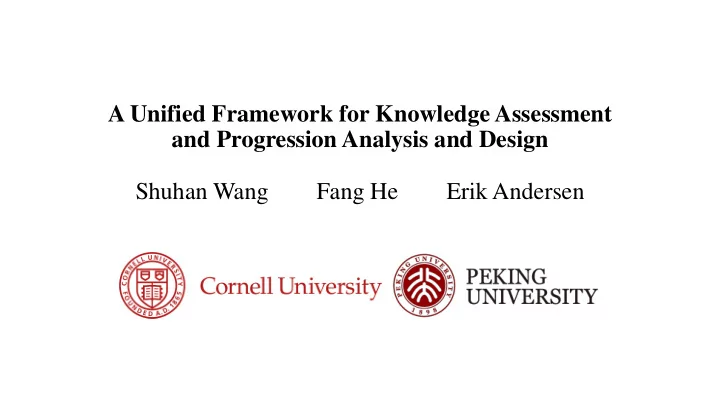

A Unified Framework for Knowledge Assessment and Progression Analysis and Design Shuhan Wang Fang He Erik Andersen
Source: Center for Game Science
Level 3 Level 2 Level 1 N5 Student’s Knowledge
Current Education System Python Python! educator content classroom Separate feedback
Our Unified Framework Knowledge Framework Assessment Performance Prediction Learning Progression Analysis
Our Unified Framework Knowledge Framework Assessment Performance Prediction Learning Progression Analysis
Knowledge Organization Study the relationship between practice problems & Build the hierarchical structure .
Partial Ordering on Practice Problems 𝑞 1 is at least as hard as 𝑞 2 if: 𝑡𝑙𝑗𝑚𝑚𝑡 𝑞 1 ⊒ 𝑡𝑙𝑗𝑚𝑚𝑡 𝑞 2
Practice Problems A B AB BCC AABC ABCB D ABCBD
Partial Ordering Graph A B AB BCC AABC ABCB D ABCBD
Our Unified Framework Knowledge Framework Assessment Performance Prediction Learning Progression Analysis
Property of Partial Ordering If 𝑞 2 is at least as hard as 𝑞 1 , then • Students who understand 𝑞 2 will also understand 𝑞 1 • Students who don’t understand 𝑞 1 will not understand 𝑞 2
Coloring Partial Ordering Graph
Coloring Partial Ordering Graph
Coloring Partial Ordering Graph
Coloring Partial Ordering Graph
Coloring Partial Ordering Graph
Coloring Partial Ordering Graph Knowledge Boundary
Knowledge Boundary Knowledge Boundary (K.B.) : the set of the hardest problems that a student can understand. We use Knowledge Boundary to model a student’s knowledge within the Partial Ordering Graph.
Our Unified Framework Knowledge Framework Assessment Performance Prediction Learning Progression Analysis
Rasch Model Student Performance 𝑄 is a function of the difference between the student’s ability 𝜄 and the problem’s difficulty 𝑐 . 𝑓 𝜄−𝑐 𝑄 𝜄, 𝑐 = 1 + 𝑓 𝜄−𝑐 Student Ability 𝜄 Problem Difficulty 𝑐 Rasch Model Unidimensional Numeric Scores Knowledge Node in Partial Our Model Boundary Ordering Graph
Distance to Knowledge Boundary In order to measure the difference between student ability 𝜄 and problem difficulty 𝑐 , We calculate the distance between Knowledge Boundary and the problem(node) in Partial Ordering Graph.
Experiments: A Japanese Assessment Tool First 10 sentences: • Students answered whether they can understand those sentences. • The responses were used for assessing students’ knowledge. Next 5-8 sentences: • Students answered how well they understand those sentences. • The responses were used as the test set for performance prediction
Results
Our Unified Framework Knowledge Framework Assessment Performance Prediction Learning Progression Analysis
When I have a “Library” of practice problems This is too hard!! Which Problem Am I learning too fast? should I learn first? When should I review Learning Progression what I have learned?
In order to automatically design learning progressions, we need to study expert-designed learning progressions .
Progression Analysis on Textbooks Genki Standard Japanese We are Looking for General Principles of designing good learning progressions.
Progression Metric: Learning Pace A student’s 𝐿𝑜𝑝𝑥𝑚𝑓𝑒𝑓 𝑇𝑗𝑨𝑓 is number of problems 𝑞 s.t. the student has learned 𝑞 or some other problem that is harder than 𝑞 . 𝑄𝑏𝑑𝑓 = ∆𝐿𝑜𝑝𝑥𝑚𝑓𝑒𝑓 𝑇𝑗𝑨𝑓 ∆𝑢𝑗𝑛𝑓 Both textbook progressions are following a similar, steady pace.
Progression Metric: Balance of Learning and Review We classify problems in a learning progression into Introduction, Reinforcement and Recombination. Problem Knowledge Classification 1 A Introduction 2 B Introduction 3 BC Introduction 4 A Reinforcement 5 C Reinforcement 6 ABC Recombination
Progression Metric: Balance of Learning and Review
Future work • Apply to Different Educational Domains • Especially Computer-Assisted Language Learning (CALL) • A Science of Progression Analysis • Pacing and Sequencing: Find the Best Principles. • Automatic and Adaptive Tutoring System • Rapid Initial Assessment • Progression Tailoring
Summary • Organizing Practice Problems into Partial Ordering Graph • A hierarchical structure of knowledge • Knowledge Assessment within Partial Ordering Graph • K nowledge B oundary -- student modeling • Distance to K.B. -- performance prediction • Analyzing Learning Progressions from Textbooks • Learning pace • Balance of Learning and Review
Recommend
More recommend